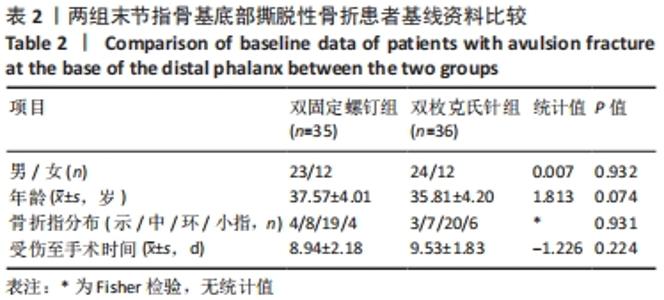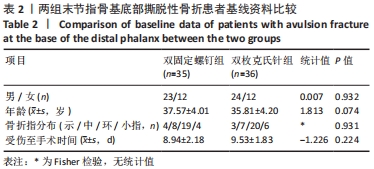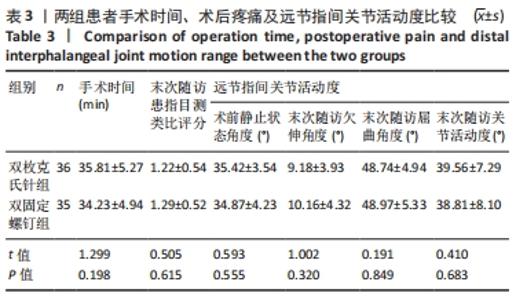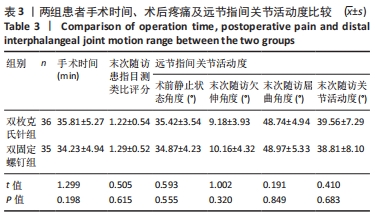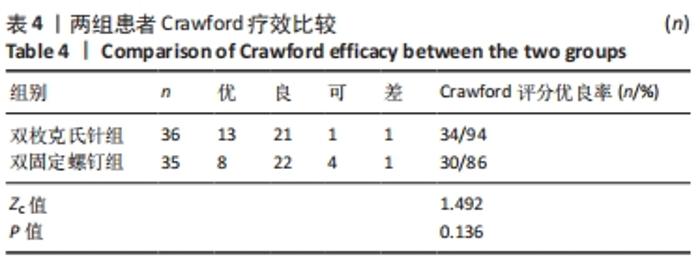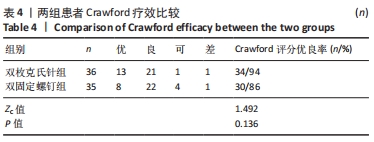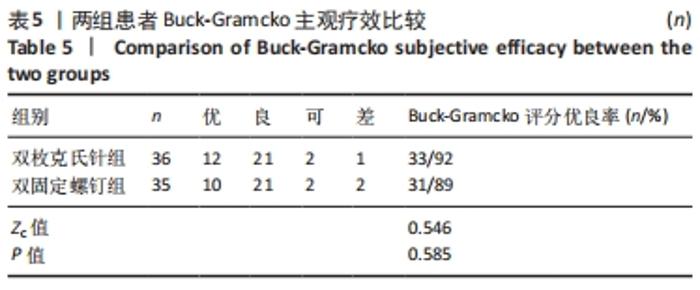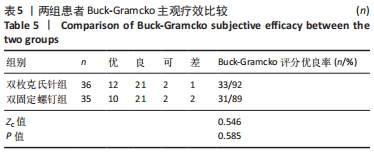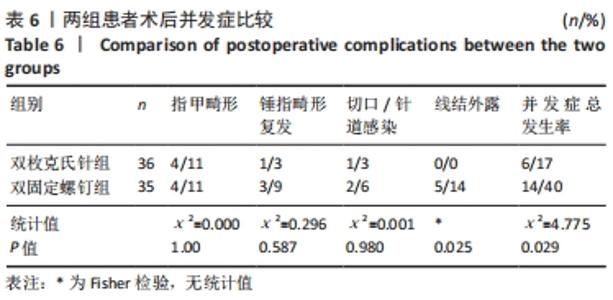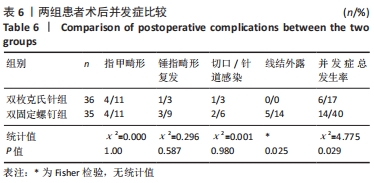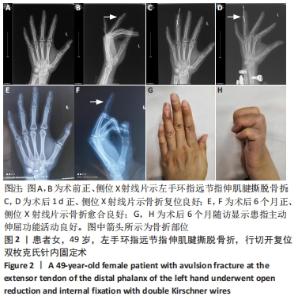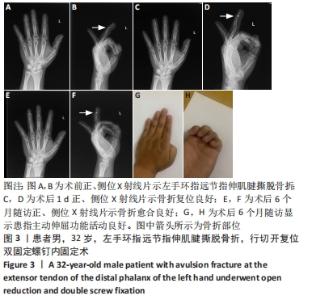[1] 宋宇轩.自制克氏针外固定架治疗急性DoyleⅠ型软组织性锤状指的临床研究[D].大连:大连医科大学,2018:1-38.
[2] WOLFE SW, HOTCHKISS RN, PEDERSON WC, et al. 格林手外科手术学[M]. 沃尔夫,田光磊,译.北京:人民军医出版社,2012:155-156.
[3] GIDDINS GE. Bony mallet finger injuries: assessment of stability with extension stress testing. J Hand Surg Eur Vol. 2016;41(7):696-700.
[4] LIN JS, SAMORA JB. Outcomes of Splinting in Pediatric Mallet Finger. J Hand Surg Am. 2018;43(11):1041.e1-1041.e9.
[5] 谢建华,刘海华,王生钰,等.双枚克氏针协同加压固定治疗末节指骨基底部撕脱性骨折[J].实用手外科杂志,2019,33(1):50-52.
[6] 齐保闯,徐显春,邱宇,等.三种手术方式治疗Doyle Ⅰ a型陈旧性锤状指畸形的效果比较[J].中国医药导报,2019,16(30):77-80.
[7] LAMARIS GA, MATTHEW MK. The Diagnosis and Management of Mallet Finger Injuries. Hand (N Y). 2017;12(3):223-228.
[8] 赵文韬,赵民.骨性锤状指的手术治疗进展[J].实用手外科杂志,2021,35(1):83-86.
[9] 房晓阳,王楠,唐田.闭合性腱性锤状指保守治疗的进展[J].实用骨科杂志, 2021,27(7):624-627.
[10] 张安静,李放,刘裕,等.不同年龄与不同位置下进行远端指间关节活动度的测量研究[J].中国康复医学杂志,2014,29(1):55-58,68.
[11] AKGUN U, BULUT T, ZENGIN EC, et al. Extension block technique for mallet fractures: a comparison of one and two dorsal pins. J Hand Surg Eur Vol. 2016;41(7):701-706.
[12] 王业伟,宋飞远,王加利,等.悬吊固定法在指骨撕脱骨折固定及止点重建中的应用[J].实用手外科杂志,2021,35(2):266-268.
[13] 郑卜真,蒋燕飞,顾世林,等.经皮引导抽出钢丝法在锤状指中的应用价值分析[J].中国现代医生,2017,55(10):80-83.
[14] 李敬矿,李斯微,凌双安,等.治疗骨性锤状指的一种新方法[J].实用手外科杂志,2017,31(3):299-302.
[15] 王洪彬,刘长安,康强军,等.克氏针张力带钢丝在撕脱性骨折型锤状指中的应用[J].临床误诊误治,2017,30(6):61-63.
[16] MAK L, AITKENS LD, NOVAK CB. Mallet finger injuries-A new method to maintain distal interphalangeal joint extension. J Hand Ther. 2016;29(3):352-355.
[17] ZHANG W, LI W, LIU Z, et al. Effectiveness of modified ishiguro technique with strengthening pressure in treatment of bony mallet fingers. Zhongguo Xiu Fu Chong Jian Wai Ke Za Zhi. 2016;30(6):705-708.
[18] O’BRIEN LJ, BAILEY MJ. Single blind, prospective, randomized controlled trial comparing dorsal aluminum and custom thermoplastic splints to stack splint for acute mallet finger. Arch Phys Med Rehabil. 2011;92(2):191-198.
[19] 王自方,明朝戈,李洋洋,等.克氏针钩拉牵引固定法治疗陈旧性骨性锤状指的疗效分析[J].中国骨与关节损伤杂志,2020,35(3):327-328.
[20] 王清铿,周晓文,符祖昶,等.改良缝合方法及持续牵拉固定治疗陈旧性骨性锤状指[J].实用手外科杂志,2021,35(1):40-41,45.
[21] 芮永军.再论锤状指的治疗方法[J].中华手外科杂志,2015,31(1):1-2.
[22] 杨元勋,王超,侯俊.骨性锤状指治疗新进展[J].中外医疗,2015,34(21):195-196.
[23] 吴月,齐爽,刘燕.对83例闭合止点撕脱性锤状指术后并发症的分析与治疗[J].实用手外科杂志,2019,33(3):264-265,274.
[24] 施建辉,朱弢,章森桥,等.微型骨锚结合腱联合加强术式治疗Ⅱ型锤状指的体会[J].浙江创伤外科,2020,25(6):1054-1055.
[25] 量子升,严雪港.两种手术方法治疗撕脱骨折锤状指的疗效对比[J].现代实用医学,2019,31(11):1481-1482.
[26] 郑力峰,谢昀,叶君健,等.骨锚钉结合克氏针与单纯克氏针治疗锤状指的比较研究[J].中华手外科杂志,2018,34(5):329-332.
[27] TANG J, WU K, WANG J, et al. Open reduction and compression with double Kirschner wires for the treatment of old bony mallet finger. J Orthop Surg Res. 2019;14(1):459.
[28] 王川.锤状指的个体化治疗及临床疗效分析[D].石家庄:河北医科大学,2017: 1-43.
[29] SCHWENDINGER P, HORLING L, SCHMOLZ W, et al. Mallet finger - A modified technique using the finger nail as a fixation point for the temporary immobilization of the distal interphalangeal joint - A biomechanical study. Clin Biomech (Bristol, Avon). 2019;69:64-70.
[30] 邵全升,苏云,马彦明,等.不经过关节面的克氏针外架治疗腱性锤状指[J].实用骨科杂志,2019,25(7):647-649.
[31] 姚茂盛,陈建球.末节指骨基底部撕脱性骨折患者行钩型克氏针内固定对手指功能的价值研究[J].中国现代药物应用,2020,14(14):86-88.
[32] 贾俊峰,李威,张国华.克氏针联合钢丝局部绑扎治疗新鲜锤状指骨折[J].中国矫形外科杂志,2019,27(22):2106-2108.
[33] STERN PJ, KASTRUP JJ. Complications and prognosis of treatment of mallet finger. J Hand Surg Am. 1988;13(3):329-334.
|
